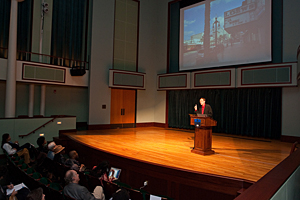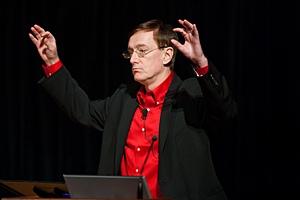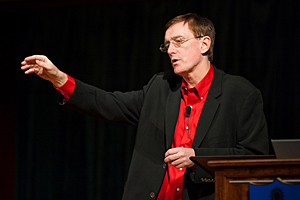
- Rozovsky wins prestigious NSF Early Career Award
- UD students meet alumni, experience 'closing bell' at NYSE
- Newark Police seek assistance in identifying suspects in robbery
- Rivlin says bipartisan budget action, stronger budget rules key to reversing debt
- Stink bugs shouldn't pose problem until late summer
- Gao to honor Placido Domingo in Washington performance
- Adopt-A-Highway project keeps Lewes road clean
- WVUD's Radiothon fundraiser runs April 1-10
- W.D. Snodgrass Symposium to honor Pulitzer winner
- New guide helps cancer patients manage symptoms
- UD in the News, March 25, 2011
- For the Record, March 25, 2011
- Public opinion expert discusses world views of U.S. in Global Agenda series
- Congressional delegation, dean laud Center for Community Research and Service program
- Center for Political Communication sets symposium on politics, entertainment
- Students work to raise funds, awareness of domestic violence
- Equestrian team wins regional championship in Western riding
- Markell, Harker stress importance of agriculture to Delaware's economy
- Carol A. Ammon MBA Case Competition winners announced
- Prof presents blood-clotting studies at Gordon Research Conference
- Sexual Assault Awareness Month events, programs announced
- Stay connected with Sea Grant, CEOE e-newsletter
- A message to UD regarding the tragedy in Japan
- More News >>
- March 31-May 14: REP stages Neil Simon's 'The Good Doctor'
- April 2: Newark plans annual 'wine and dine'
- April 5: Expert perspective on U.S. health care
- April 5: Comedian Ace Guillen to visit Scrounge
- April 6, May 4: School of Nursing sponsors research lecture series
- April 6-May 4: Confucius Institute presents Chinese Film Series on Wednesdays
- April 6: IPCC's Pachauri to discuss sustainable development in DENIN Dialogue Series
- April 7: 'WVUDstock' radiothon concert announced
- April 8: English Language Institute presents 'Arts in Translation'
- April 9: Green and Healthy Living Expo planned at The Bob
- April 9: Center for Political Communication to host Onion editor
- April 10: Alumni Easter Egg-stravaganza planned
- April 11: CDS session to focus on visual assistive technologies
- April 12: T.J. Stiles to speak at UDLA annual dinner
- April 15, 16: Annual UD push lawnmower tune-up scheduled
- April 15, 16: Master Players series presents iMusic 4, China Magpie
- April 15, 16: Delaware Symphony, UD chorus to perform Mahler work
- April 18: Former NFL Coach Bill Cowher featured in UD Speaks
- April 21-24: Sesame Street Live brings Elmo and friends to The Bob
- April 30: Save the date for Ag Day 2011 at UD
- April 30: Symposium to consider 'Frontiers at the Chemistry-Biology Interface'
- April 30-May 1: Relay for Life set at Delaware Field House
- May 4: Delaware Membrane Protein Symposium announced
- May 5: Northwestern University's Leon Keer to deliver Kerr lecture
- May 7: Women's volleyball team to host second annual Spring Fling
- Through May 3: SPPA announces speakers for 10th annual lecture series
- Through May 4: Global Agenda sees U.S. through others' eyes; World Bank president to speak
- Through May 4: 'Research on Race, Ethnicity, Culture' topic of series
- Through May 9: Black American Studies announces lecture series
- Through May 11: 'Challenges in Jewish Culture' lecture series announced
- Through May 11: Area Studies research featured in speaker series
- Through June 5: 'Andy Warhol: Behind the Camera' on view in Old College Gallery
- Through July 15: 'Bodyscapes' on view at Mechanical Hall Gallery
- More What's Happening >>
- UD calendar >>
- Middle States evaluation team on campus April 5
- Phipps named HR Liaison of the Quarter
- Senior wins iPad for participating in assessment study
- April 19: Procurement Services schedules information sessions
- UD Bookstore announces spring break hours
- HealthyU Wellness Program encourages employees to 'Step into Spring'
- April 8-29: Faculty roundtable series considers student engagement
- GRE is changing; learn more at April 15 info session
- April 30: UD Evening with Blue Rocks set for employees
- Morris Library to be open 24/7 during final exams
- More Campus FYI >>
8:17 a.m., Oct. 6, 2009----Musician and musicologist Ned Sublette believes that Cuba and New Orleans are the two places that most symbolize the rich cultural and musical contributions of African peoples in the Americas.
Sublette made his remarks during his keynote address, “Listening Backward,” on Thursday, Oct. 1, in Gore Recital Hall of the Roselle Center for the Arts as part of the Sound Print Record: African American Legacies Symposium.
The two-day interdisciplinary symposium was held in conjunction with an art exhibition of the same name that will be on view at Mechanical Hall Gallery through Dec. 6.
In welcoming the attendees, University of Delaware President Patrick Harker noted that the University was fortunate to house one of the nation's richest and largest collections of works by 20th century African American artists.
“It's such a magnificent resource for this symposium, and has long been used as a centerpiece for multidisciplinary scholarship and research, for education and for outreach and engagement,” Harker said. “It is truly priceless to this University and its visitors.”
Harker also noted the contributions of UD faculty and staff, as well as the nation's most respected scholars in African American music, including writers, artists, critics, historians, musicologists, producers, and performers. He also welcomed the symposium's keynote speaker, Sublette.
“His latest book, The Year Before the Flood, is a highly personal story about the pre-Katrina year he spent as a visiting scholar at Tulane University, writing what would become The World That Made New Orleans,” Harker said. “It's both a memoir and a penetrating social history -- a beautiful meditation on sound and society, race and power, history and redemption.”
Coming from a background that includes making and collecting recorded music, Sublette said that much of the music in the African American tradition has yet to be preserved in the digital age.
“We are here to talk about records today, and after making a number of them myself, I'm more interested than ever in live music and community, which is yet another reason to advocate for Cuba and New Orleans, which I do,” Sublette said. “I place music at the center of understanding, and I use it to investigate history.”
Much of his attention in recent years, Sublette said, has been devoted to the exploration of the roots of a common musical language and the history it represents.
“It's important to ask the right question, and when I wrote my book, Cuba and Its Music, I asked a right question: how and why are Afro Cuban and African American music so different,” Sublette said. “It's a question that comes up anytime people from the two different traditions try to jam, because these two great musical systems are so different that they practically function as opposites that describe the hemisphere.”
While much of this music eventually made its way back to Europe, where it evolved and was woven into the works of famous composers, it has had a far more important meaning for those who were enslaved and their descendants across the Americas.
“The great feat of kidnapped Africans up and down the hemisphere was that they resisted their own erasure to thrive and grow, and they did it through music, albeit with very different strategies in the north and south,” Sublette said. “In Cuba, where enslaved people could assemble behind closed doors to sing in ancestral languages, dance ancestral dances, play ancestral drums, be ridden by mpungu or orishas or vodun, they were able to keep their culture with a remarkable degree of orthodoxy.”
Sublette noted the contributions of Ivor Miller, author of Voice of the Leopard, and C.L.R. James, whose 1938 book, The Black Jacobins, included the Haitian Revolution in its historical narrative.
“One of the two or three most significant events of hemispheric history and a turning point in world history, the Haitian Revolution, was also a generative explosion of popular music in the hemisphere,” Sublette said. “Up until James, the Haitian Revolution simply was not in history books, and even today historians who deal with it have a reputation as edgy.”
Another important contribution to the understanding of this musical and historical heritage was the 1936 field recording project undertaken by Alan Lomax in Haiti, Sublette said.
“No one had done a field recording project of the folk music of Haiti before,” Sublette said. “It took Lomax almost another 30 years to get to Guadeloupe, but when he got there in the 1960s, he was the first to do field recording there, too.”
Sound recordings, Sublette noted, meant that African American music could be documented and historicized, while serving as an empowering and transforming force that also offered new possibilities for black music.
“The invention of recording suddenly allowed African-derived performance styles to be heard and financially supported by a wide public at a time when the color-coded castes were kept physically separate in the United States and other places in the hemisphere,” Sublette said. “It gave black consumers power in the market to determine what music could be heard and gave them the ability to elevate their own to stardom, at a time when higher education and the professions were closed to them.”
Evidence of this evolving transformation can be seen in the emergence of “race records” which began in the 1920, Sublette said.
“Race, which is a biological fiction, was now a market segment, which actually was what it had always been,” Sublette said. “All these seemingly new styles were complex, nuanced products of a long, largely undocumented evolution that had undergone the still-recent, explosively transformative effect of emancipation.”
Sublette said the problem of understanding this musical heritage reflects the larger issue of understanding African history.
“So far as archeology can inform history, black Africa outside the Egyptian kingdoms didn't exist -- no culture, no civilization,” Sublette said. “But there are other ways of attacking the problem, which rely on working backward from the present, and taking oral tradition into account. What some people call linguistic paleontology proved to be a very useful tool in deducing basic facts about African, which is to say, human history.”
Sublette said that the north-to-south map of African musical practice was transposed roughly to the New World, with the music of the immediately sub-Saharan Sahelian region of Africa surfacing in the United States, while the music of the African forest made its way to the southern Americas.
A common denominator was the Kongo influence, which Sublette said was seen everywhere in the hemisphere. Complementing this north-south hemispheric representation was that of a Europe divided into a Protestant north and a Catholic south, which resulted in the emergence of two great zones of musical practice, Sublette said.
“I'm not saying one is better than the other, or even that one is more African than the other,” Sublette said. “But in Cuba, the conditions existed for an explicitly African culture to flourish into the present day, whereas in the United States, an implicitly African culture, with a heavy reliance on codes, developed a different way to resist erasure by the psychologically cruelest of all slaving regimes, the North American one, which took away the African's past, prohibiting languages, drums, religion and future, with the one-drop rule guaranteeing no path to freedom unto the nth generation.”
Ironically enough, the dividing line for these two great zones, Sublette said, is Canal Street in New Orleans, described in a guidebook as the widest street in America.
“That's because it wasn't a street. Nor, despite its name, was it a canal. The canal was never dug,” Sublette said. “In the late 1830s it was a no man's land that divided English-speaking New Orleans, which had the railroad, from the separate municipality of French-speaking New Orleans, which had Congo Square.”
Sublette said that the birth of jazz as developed through negotiation between the music of English-speaking, Protestant field hands represented by Louis Armstrong, and Sidney Bechet and Jelly Roll Morton from the Catholic, downtown, music-reading Creoles, was more than just a local phenomenon.
“It was the tectonic edge of two great musical systems coming into contact,” Sublette said. “For this reason I say that New Orleans is not, as commonly stated, the least American city. I think it's the most American city.”
Sublette also believes that despite the passing of individuals who may have carried songs and forms of music from an oral cultural tradition, much remains to be uncovered, documented and recorded as part of a larger historical record.
“Egyptologists believe that maybe 30 percent of Egyptian artifacts are still waiting to be discovered beneath the shifting sands of the desert,” Sublette said. “How much more of the historic Afro-Atlantic sound world is still waiting to be discovered. History is alive and it might get recorded for the first time next week.”
The symposium was supported by a grant of $15,000 from the Delaware Humanities Forum, a state program of the National Endowment for the Humanities.
Article by Jerry Rhodes
Photos by Kevin Quinlan




